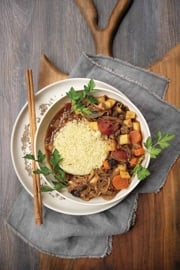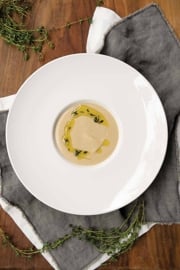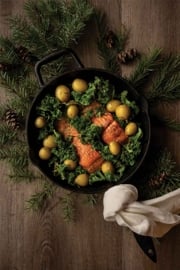Turkey with Apple Fig Chutney and Parsnip Purée

Poaching turkey breast is an easy, hands-off way to cook the lean meat without the worry of drying it out. Tangy goat cheese is an exciting replacement for butter in vegetable mashes such as this parsnip version. And the chutney further assures that the dish is big on flavour.
2 red-skinned apples, diced
1 cup (250 mL) dried Mission figs, stems trimmed and quartered
1/2 cup (125 mL) apple cider
1 shallot, chopped
2 tsp (10 mL) honey
2 tsp (10 mL) chopped fresh ginger
1 tsp (5 mL) orange zest
1/2 tsp (2 mL) brown mustard seeds (optional)
1/4 tsp (1 mL) ground cloves
1/2 tsp (2 mL) salt, divided
1 1/2 lbs (750 g) skinless, boneless turkey breast
4 medium-sized parsnips, peeled and diced
1 1/2 oz (43 g) soft goat cheese
1 Tbsp (15 mL) chopped rosemary
To make the chutney, place apples, figs, apple cider, shallot, honey, ginger, orange zest, mustard seeds (if using), cloves, and 1/4 tsp (1 mL) salt in medium saucepan. Bring to a boil, reduce heat to medium-low and simmer uncovered until most of the liquid has evaporated and fruit is tender, about 20 minutes.
To poach turkey, place breasts in pot large enough so they lie flat in a single layer. Add 2 pinches of salt and enough water to completely cover turkey by at least 1 in (2.5 cm). Bring water to very slight simmer with just a few bubbles breaking the surface and cook, partially covered, for 15 minutes, or until meat is cooked through. Adjust heat as needed during cooking to maintain slight simmer and skim off any foam that forms on surface of water.
Place parsnips in steamer basket and steam over 1 in (2.5 cm) water until very tender. You can also boil the parsnips. Place parsnips in food processor container along with goat cheese, rosemary, and remaining salt. Blend until smooth.
To serve, spread parsnip purée on serving plates and top with slices of turkey. Season turkey with salt and pepper to taste. Add dollops of apple fig chutney over turkey.
Serves 4.
Each serving contains: 381 calories; 45 g protein; 6 g total fat (3 g sat. fat, 0 g trans fat); 56 g total carbohydrates (35 g sugars, 8 g fibre); 406 mg sodium
Talking turkey
Any way you slice it, turkey is a rich source of protein as well as several nutrients, including B vitamins and selenium.
source: "Gobble, Gobble", alive #384, October 2014





